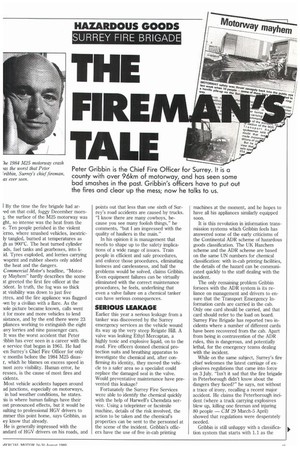THE FIRE TALE
Page 47

If you've noticed an error in this article please click here to report it so we can fix it.
I By the time the fire brigade had arred on that cold, foggy December morn4, the surface of the M25 motorway was ght, so intense was the heat from the e. Ten people perished in the violent 'um, where smashed vehicles, inextricly tangled, burned at temperatures as 4h as 900°C. The heat turned cylinder ads, fuel tanks and gearboxes, into Iiid. Tyres exploded, and lorries carrying wsprint and rubber sheets only added the heat and the dangers.
Commercial Motor's headline, "Motoriy Mayhem" hardly describes the scene at greeted the first fire officer at the Hdent. In truth, the fog was so thick at visibility was down to just five E.-tres, and the fire appliance was flagged rwn by a civilian with a flare. As the iole picture became known, calls went Lt for more and more vehicles to lend sistance, and by the end there were 23 pliances working to extinguish the eight 'avy lorries and nine passenger cars. It was the worst accident that Peter ibbin has ever seen in a career with the e service that began in 1961. He had :en Surrey's Chief Fire Officer for only 'e months before the 1984 M25 disasr, which he blames on excess speed in nost zero visibility. Human error, he resses, is the cause of most fires and cidents.
Most vehicle accidents happen around ad junctions, especially on motorways, in bad weather conditions, he states. Us is where human failings have their ost pronounced effects, but it would be suiting to professional HGV drivers to [miner this point home, says Gribbin, as ey know that already.
He is generally impressed with the andard of HGV drivers on his roads, and points out that less than one sixth of Surrey's road accidents are caused by trucks. "I know there are many cowboys, because you see many foolish things," he comments, "but I am impressed with the quality of hauliers in the main."
In his opinion it is management that needs to shape up to the safety implications of a wide range of issues. Train people in efficient and safe procedures, and enforce those procedures, eliminating laziness and carelessness, and half the problems would be solved, claims Gribbin. Even equipment failures can be virtually eliminated with the correct maintenance procedures, he feels, underlining that even a valve failure on a chemical tanker can have serious consequences.
Earlier this year a serious leakage from a tanker was discovered by the Surrey emergency services as the vehicle wound its way up the very steep Reigate Hill. A valve was leaking Ethyl Mercaptan, a highly toxic and explosive liquid, on to the road. Fire officers donned chemical protection suits and breathing apparatus to investigate the chemical and, after confirming its identity, they moved the vehicle to a safer area so a specialist could replace the damaged seal in the valve. Would preventative maintenance have prevented this leakage?
Fortunately the Surrey Fire Services were able to identify the chemical quickly with the help of Harwell's Chemdata service. Using a teleprinter or facsimile machine, details of the risk involved, the action to be taken and the chemical's properties can be sent to the personnel at the scene of the incident. Gribbin's officers have the use of five in-cab printing machines at the moment, and he hopes to have all his appliances similarly equipped soon.
It is this revolution in information transmission systems which Gribbin feels has answered some of the early criticisms of the Continental ADR scheme of hazardous goods classification. The UK Hazchem scheme and the ADR scheme are based on the same UN numbers for chemical classification: with in-cab printing facilities, the details of the hazard can be communicated quickly to the staff dealing with the incident.
The only remaining problem Gribbin forsees with the ADR system is its reliance on management and drivers to ensure that the Transport Emergency Information cards are carried in the cab. Only one card should be carried, and that card should refer to the load on board. Surrey Fire Brigade has reported two incidents where a number of different cards have been recovered from the cab. Apart from being in contravention of the ADR rules, this is dangerous, and potentially lethal, for the emergency teams dealing with the incident.
While on the same subject, Surrey's fire chief welcomes the latest carriage of explosives regulations that came into force on 3 July. "Isn't it sad that the fire brigade in Peterborough didn't know about the dangers they faced?" he says, not without a trace of irony, recalling a recent major accident. He claims the Peterborough incident (where a truck carrying explosives blew up, killing one fireman and injuring 80 people — CM 29 March-5 April) showed that regulations were desperately needed.
Gribbin is still unhappy with a classification system that starts with 1.1 as the




































































































